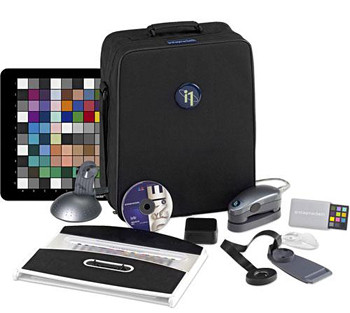Signage Education | Color Management Part 5, What tools are used to manage color?
Posted in: Uncategorized
In previous articles on color management, we’ve explored factors that affect color output, and presented concepts to consider in developing a proper color management process. In this, the fifth in a series on color management, we’ll look at tools available to better manage color output.
Hygrometer
A hygrometer is an instrument that measures relative humidity. Since humidity can affect color output, the use of hygrometer is useful in determining if humidity is within an acceptable range prior to printing. If humidity is not within an acceptable range, your air conditioner or a humidifier can be used to adjust relative humidity. Inexpensive digital, wall-mounted hygrometers are available for installation near your printer. Some hygrometers have an integral temperature display and have an audible alarm that’s useful in alerting you when humidity is outside a specified range.
Humidifier
A humidifier is an appliance that increases the humidity in an enclosed area; a single room, an entire house or shop. For sign shops, a simple point-of-use humidifier may be suitable to humidify a single room where your printer is located. If there’s a significant variance in humidity between the time when your media profile is created and when you print, color output may not be accurate. When humidity drops below an acceptable level, the use of a humidifier to increase humidity will help ensure consistent color output.
Color Spectrophotometer
Perhaps oversimplified, a spectrophotometer is a device used to measure color. If predictable color output is desired, this device is an absolute requirement as it is needed to profile your monitor, scanner and media used in your printer.
One such device is the I1 by X-Rite as shown below.

This product is a combination of hardware and software, probably everything you would need to profile your scanner, monitor and media. This product is capable of measuring both emitted light (for monitors) and reflected light (printed material). The X1 Xtreme also includes a head used for measuring ambient light, which can affect reflected light and color.
In addition to a hand held device for reading colors, a color reflective target is included for profiling your scanner. The measuring device can be mounted in a bracket that can hung over your monitor. A counter weight hangs over the back of your monitor to hold the measuring device in place against the monitor. Provided software then uses a binary search, emitting light in progressively smaller areas to find the location of the device on the monitor. Once the measuring device is “found” in this manner, a series of colors are displayed in front of the measuring device. The device measures the colors displayed and a profile is created for your monitor. This profile compensates for differences between a known, fixed color controlled by the software, and the actual color displayed on your monitor as measured by the device.
Pantone Swatch Books
Pantone is a company known for their Pantone Matching System, a proprietary color space used in a number of industries to communicate color. One of the tools available are printed books of color swatches, each with a unique identifier commonly used to reference that color. The swatch books may include the corresponding CMYK percentages to produce a given color. Your RIP may have the ability to scan individual swatches to create libraries for referencing specific spot colors in software – the RIP will convert referenced spot colors to the required CMYK values for a specific media profile.
Printer and RIP
Your RIP (Raster Image Processor) and printer may provide some tools to ensure your production process is consistent. For example, your printer may have presets that allow you to save media-specific print parameters. These parameters may include the temperature for the printers heater and dryer, print method (unidirectional or bidirectional) and other parameters that may affect color output. Optimal settings should be determined in conjunction with the media manufacturer and saved to your printer’s presets for use each time you print to that media. In this manner, the same parameters used when profiling are also used when printing.
Similarly, your RIP will allow the specification of a given profile, which can include defaults for the printer’s heater, dryer and printing mode.
Regardless of the method you chose to store and reference applicable print parameters, your printer should be well maintained and calibrated. Follow the manufacturer’s guidance for periodic cleaning. Perform a test print at the start of each day to ensure your printer is operating properly.
Vendor Solutions
Some printer manufacturers may provide a proprietary method of reproducing colors accurately. For example, Roland has a color space called “Roland Color” designed to be used with a specific workflow. Color swatches are printed on media to be used as reference in selecting a color. In software, you select the spot color corresponding to the swatch of the desired color. The claim is that you know you can reproduce a given color because the reference color was created on your printer, with your ink, in your environment and on your specific media.
Though Roland Color provides the basis for reliably reproducing color, you must print swatches on each media type, and you still must control environmental factors (temperature and humidity) and printer configuration must be consistent. Unfortunately, the use of such a proprietary color space assumes your customers have access to swatches on the target media. You must print and provide the swatches before your customer can properly prepare their artwork.
The creation of a proper color management process involves an understanding of factors that affect color output, then using tools available to control those factors, to ensure predictable color output.
For more information, contact:
Spectrum Signs
23382 Madero Suite L
Mission Viejo, CA 92691
(949) 297-3800
Return to: Signage Education | Color Management Part 5, What tools are used to manage color?
Social Web